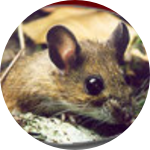About This Project
Since 1980, worldwide obesity has doubled (WHO). Brown and beige fat cells burn calories, making them targets for potential obesity drugs. The lab mouse/rat strains used to study these cells are highly inbred at stable temperatures and lighting, isolating them from the strongest stimuli for brown fat activation. We aim to establish the utility of Peromyscus leucopus (white-footed mouse) as a better model to study brown/beige fat by measuring responses of brown/beige fat specific genes to cold.
Ask the Scientists
Join The DiscussionWhat is the context of this research?
White fat, such as the abdominal fat in obese individuals, stores energy. Brown and beige fat cells use energy to produce heat and their ability to burn energy grows in response to cold. Stimulation of brown fat to burn energy shows promise as a potential drug target to treat obesity.
The animal models used to study brown/beige fat most expeditiously must rely on brown fat for survival, yet be amenable to study in the lab. Common lab mice/rats are highly inbred at stable temperatures and daylight, isolating them from the main stimuli for brown fat. Indeed, brown fat no longer responds to shortened daylight in common lab rats. This experiment will assess the extent of brown/beige fat cell activation through gene expression analyses in a novel model, P. leucopus, in response to cold.
What is the significance of this project?
Although there is great interest in brown/beige fat biology, the lab mice and rats currently used have limitations because they are highly inbred in conditions that do not favor recruitment or reliance on brown fat. Our studies will be the first to examine the utility of P. leucopus as a model to study brown/beige fat regulation. P. leucopus are unique compared to other wild-caught animals in that they can be studied using typical mouse experimental procedures (http://stkctr.biol.sc.edu/). Our facility can house these wild-caught animals outside or inside in stable conditions. Should P. leucopus be a strong model for the study of brown/beige fat biology, these experiments will expedite the discovery process and make findings more translatable to the treatment of human obesity.
What are the goals of the project?
We will determine the utility of P. leucopus (white-footed mouse) as a better model to study brown/beige fat biology and through this improve the tools available to obesity scientists for development of treatments. The funds requested will be used to measure the responsiveness of genes in brown/white fat depots to cold. These experiments will expand on other analyses currently underway in my lab. We plan to publish the results together in an open access journal. Ultimately, our goal is to show that in P. leucopus, significant brown/beige fat activation occurs in response to the cold. We will use typical mouse methodologies to illustrate the utility of a stronger, more appropriate, and more translationally relevant model to study brown/beige fat regulation.
Budget
The proposed experiments will measure in outbred P. leucopus the response of genes in 3 fat depots to cold. The genes chosen are indicators of fat cell identity and brown/beige fat activity. Fat samples have been dissected and are ready for analysis. All animal work was approved by the Trent University Animal Care Committee (vet, scientists, and community members) and followed regulations of the Canadian Council for Animal Care.
We are currently using histology and western blot analyses to assess the morphological composition of these fat samples. However, to quantify the cellular composition and activity of brown/beige cells, the best method is through gene expression analyses by real-time quantitative RT-PCR. RNA will be extracted using RNeasy Lipid Tissue Mini kits (Qiagen), cDNA will be synthesized using a Superscript III First-Strand Synthesis System (Invitrogen), and gene expression will be quantified using TaqMan Gene Expression Assays (Applied Biosystems).
Endorsed by
Meet the Team
Team Bio
Dr. Bates and her team of talented trainees work closely with faculty members in the Biology department and garner expertise from the Trent-partnered Ontario Ministry of Natural Resources. Staff are adept at working with a diversity of animals and are actively engaged with the Canadian Association in Lab Animal Science. The facility is accredited by the Canadian Council on Animal Care, and licensed with the Ontario Ministry of Agriculture, Food, and Rural Affairs.
Holly Bates
Dr. Bates is an Assistant Professor in the Biology Department at Trent University, Peterborough, Canada where she studies the processes that regulate recruitment and activation of brown adipose tissue and how these processes can be exploited for the generation of anti-obesity therapeutics. Dr. Bates is combining her expertise using mouse and rat models to study obesity and Diabetes, with the unique expertise and facilities available at Trent University for studying wild mammalian populations. Thus, Dr. Bates is working to close the gap between physiologists in the natural and health sciences and to highlight the importance of finding the most appropriate animal models to study human disease.
Her research training includes completion of a postdoctoral fellowship at the Lunenfeld-Tannenbaum Research Institute of Mount Sinai Hospital in Toronto, where she studied the interaction between gut hormones and stress hormones and their contribution to development of Diabetes and obesity. These studies were done using knockout mouse models, cell culture, and molecular methodologies. Dr. Bates completed her PhD in Physiology at the University of Toronto. During this time, she described the effects of psychological stress on development of Diabetes and obesity in a rat model of obese Type 2 Diabetes.
Lab Notes
Nothing posted yet.
Project Backers
- 7Backers
- 5%Funded
- $276Total Donations
- $39.43Average Donation

